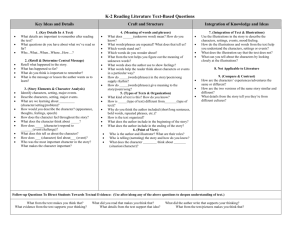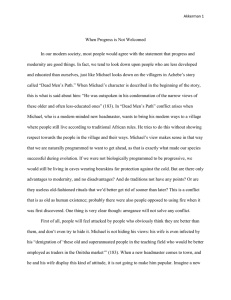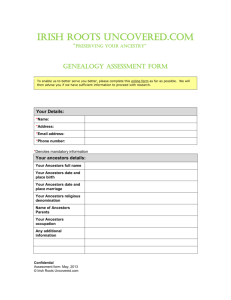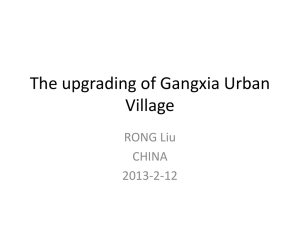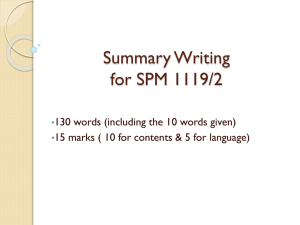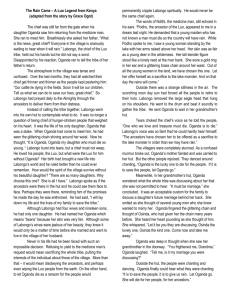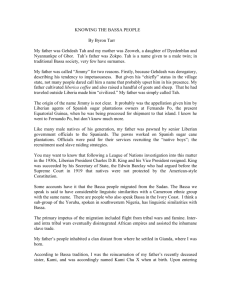KS2
advertisement
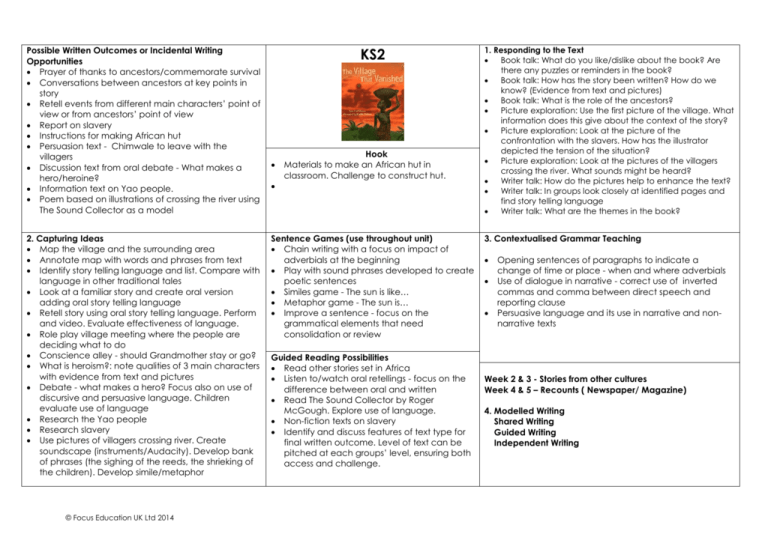
Possible Written Outcomes or Incidental Writing Opportunities Prayer of thanks to ancestors/commemorate survival Conversations between ancestors at key points in story Retell events from different main characters’ point of view or from ancestors’ point of view Report on slavery Instructions for making African hut Persuasion text - Chimwale to leave with the villagers Discussion text from oral debate - What makes a hero/heroine? Information text on Yao people. Poem based on illustrations of crossing the river using The Sound Collector as a model 2. Capturing Ideas Map the village and the surrounding area Annotate map with words and phrases from text Identify story telling language and list. Compare with language in other traditional tales Look at a familiar story and create oral version adding oral story telling language Retell story using oral story telling language. Perform and video. Evaluate effectiveness of language. Role play village meeting where the people are deciding what to do Conscience alley - should Grandmother stay or go? What is heroism?: note qualities of 3 main characters with evidence from text and pictures Debate - what makes a hero? Focus also on use of discursive and persuasive language. Children evaluate use of language Research the Yao people Research slavery Use pictures of villagers crossing river. Create soundscape (instruments/Audacity). Develop bank of phrases (the sighing of the reeds, the shrieking of the children). Develop simile/metaphor © Focus Education UK Ltd 2014 KS2 Hook Materials to make an African hut in classroom. Challenge to construct hut. Sentence Games (use throughout unit) Chain writing with a focus on impact of adverbials at the beginning Play with sound phrases developed to create poetic sentences Similes game - The sun is like… Metaphor game - The sun is… Improve a sentence - focus on the grammatical elements that need consolidation or review Guided Reading Possibilities Read other stories set in Africa Listen to/watch oral retellings - focus on the difference between oral and written Read The Sound Collector by Roger McGough. Explore use of language. Non-fiction texts on slavery Identify and discuss features of text type for final written outcome. Level of text can be pitched at each groups’ level, ensuring both access and challenge. 1. Responding to the Text Book talk: What do you like/dislike about the book? Are there any puzzles or reminders in the book? Book talk: How has the story been written? How do we know? (Evidence from text and pictures) Book talk: What is the role of the ancestors? Picture exploration: Use the first picture of the village. What information does this give about the context of the story? Picture exploration: Look at the picture of the confrontation with the slavers. How has the illustrator depicted the tension of the situation? Picture exploration: Look at the pictures of the villagers crossing the river. What sounds might be heard? Writer talk: How do the pictures help to enhance the text? Writer talk: In groups look closely at identified pages and find story telling language Writer talk: What are the themes in the book? 3. Contextualised Grammar Teaching Opening sentences of paragraphs to indicate a change of time or place - when and where adverbials Use of dialogue in narrative - correct use of inverted commas and comma between direct speech and reporting clause Persuasive language and its use in narrative and nonnarrative texts Week 2 & 3 - Stories from other cultures Week 4 & 5 – Recounts ( Newspaper/ Magazine) 4. Modelled Writing Shared Writing Guided Writing Independent Writing
